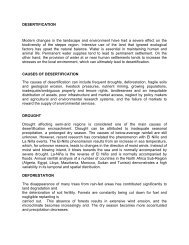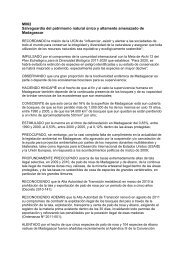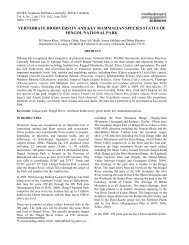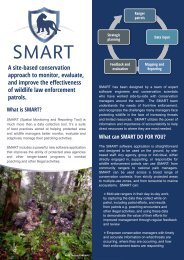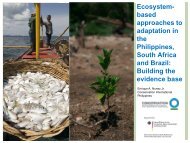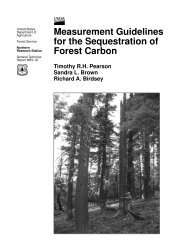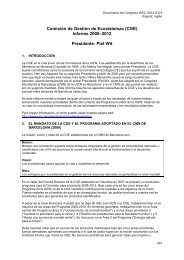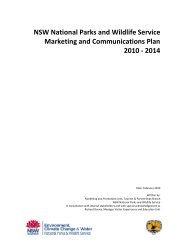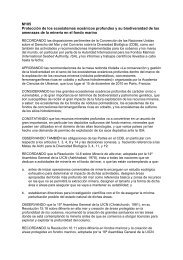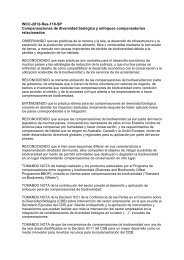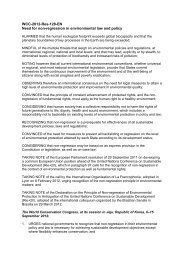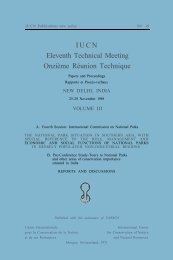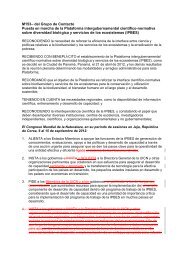Create successful ePaper yourself
Turn your PDF publications into a flip-book with our unique Google optimized e-Paper software.
Executive SummaryFor 2009–12, <strong>IUCN</strong> organized its Programme around five programme areas and ten broad globalresults. The programme areas covered <strong>IUCN</strong>’s core work on conserving biodiversity and thematicprogramme areas on climate change, energy, managing ecosystems for human wellbeing and greeneconomy.<strong>IUCN</strong>’s top five lessons inclu<strong>de</strong>:• Basic science, such as the <strong>IUCN</strong> Red List of Threatened Species, serves multiple purposes asa global public good.• Policy influence and practical <strong>de</strong>monstration can create a virtuous circle of action and policyinfluence that is positive for biodiversity and human wellbeing.• <strong>IUCN</strong>’s proven role of convening local stakehol<strong>de</strong>rs and empowering the most vulnerablesegments of society has emerged as a key strategy in a variety of efforts to improve rurallivelihoods while managing and restoring ecosystems.• Nature does provi<strong>de</strong> solutions to the global challenges of economic <strong>de</strong>velopment, foodsecurity, climate change and disaster risk reduction.• <strong>IUCN</strong> leverages more knowledge, influence and action as a Union than as a singleorganization.This programme report presents highlights from the 2009–12 period for each programme area.• <strong>IUCN</strong>’s progress in conserving biodiversity inclu<strong>de</strong>d a rapid expansion in the knowledgeand tools avai<strong>la</strong>ble for biodiversity conservation, particu<strong>la</strong>rly from the <strong>IUCN</strong> Red List ofThreatened Species, conservation p<strong>la</strong>nning and action that inclu<strong>de</strong>d species conservation,improvements in the coverage and management effectiveness of protected areas,management and restoration of forest <strong>la</strong>ndscapes, watersheds, dry<strong>la</strong>nds and mangroveecosystems and policy influencing, particu<strong>la</strong>rly in the Convention on Biological Diversity(CBD).• <strong>IUCN</strong>’s work on climate change focused primarily on influencing the United NationsFramework Convention on Climate Change (UNFCCC) and national policy frameworks whilepromoting and <strong>de</strong>monstrating pro-poor approaches to REDD+ and ecosystem basedadaptation to climate change. The work in this programme area <strong>de</strong>monstrated how nature canprovi<strong>de</strong> solutions to the challenges posed by climate change.• Progress against the global results for the programme area on energy was mo<strong>de</strong>st; however,<strong>IUCN</strong> was able to have some influence over policy regimes and private sector partners,building support for pro-biodiversity energy regimes.• Most of <strong>IUCN</strong>’s projects in the field work directly with the rural poor to <strong>de</strong>monstrate howmanaging ecosystems for human wellbeing can provi<strong>de</strong> tangible benefits. Most of the workwas at the <strong>de</strong>monstration scale, yielding solid yet mo<strong>de</strong>st benefits to target groups; however, itis expected that the techniques <strong>de</strong>monstrated will be replicated by <strong>IUCN</strong> Members andpartners.• <strong>IUCN</strong> ma<strong>de</strong> mo<strong>de</strong>st but promising gains on greening the world economy, particu<strong>la</strong>rly inbuilding the knowledge base on the economic value of biodiversity, while influencing privatesector companies to improve their performance.As an organization, <strong>IUCN</strong> ma<strong>de</strong> significant progress in growing the network and effectivecommunications:330



